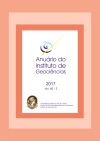Foraminiferal Assemblage and Bioindicators for Evaluation of the Anthropogenic Impact in the Guanabara Bay, Rio de Janeiro, SE Brazil
DOI:
https://doi.org/10.11137/2017_3_386_397Palavras-chave:
Pollution, Foraminifera, Oil spilling, Guanabara BayResumo
In January 2000, Guanabara Bay in Rio de Janeiro experienced a major oil spilling caused by a break down in one PETROBRAS oil pipeline. Over than 1.3 tons of fuel oil escaped into the bay water in the northern region. Studies of foraminiferal taphonomic assemblages in sediment samples collected on three periods in the same stations, before and after the spilling, were important for the pollution impact evaluation during eight years. In 2005, in the north region, TOC values were higher than in 1999. It was observed the increase of test abnormalities, corrosion and dwarism. Abundance and species richness reduced in 2005 and increased in 2008 but they did not reach the 1999 levels. Trends of dominant species confirmed the increase of pollution values in 2005: Abundance of A. tepida increased while B. elegantissima reduced. In 2008 there was an increase in the species richness with the occurrence of agglutinated species.Downloads
Publicado
2019-07-30
Edição
Seção
Artigos
Licença
Os artigos publicados nesta revista se encontram sob a llicença Creative Commons — Atribuição 4.0 Internacional — CC BY 4.0, que permite o uso, distribuição e reprodução em qualquer meio, contanto que o trabalho original seja devidamente citado.
















 Exceto onde indicado de outra forma, o conteúdo deste site é licenciado sob uma licença
Exceto onde indicado de outra forma, o conteúdo deste site é licenciado sob uma licença 